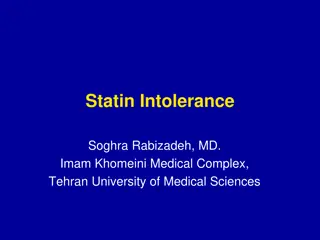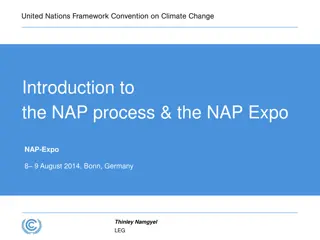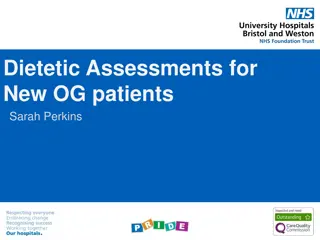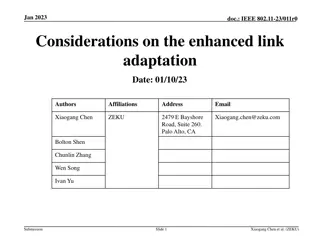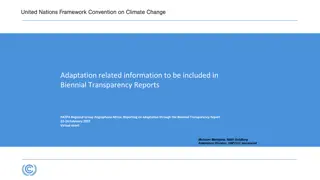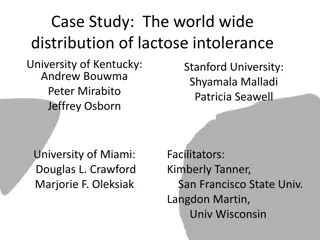Understanding Lactose Intolerance and Nutritional Adaptation
Lactose intolerance is the inability to digest lactose in milk. This condition is prevalent among adults due to decreased lactase production. Symptoms include bloating, cramping, gas, diarrhea, nausea, and vomiting. Learn how lactose intolerance is a natural human adaptation and discover the geographic distribution of this trait worldwide.
Download Presentation

Please find below an Image/Link to download the presentation.
The content on the website is provided AS IS for your information and personal use only. It may not be sold, licensed, or shared on other websites without obtaining consent from the author. Download presentation by click this link. If you encounter any issues during the download, it is possible that the publisher has removed the file from their server.
E N D
Presentation Transcript
Adaptation Adaptation to to Lactose Do you drink milk? Or do you avoid drinking milk and consuming milk products because they cause you discomfort? If the latter is the case, then you may have trouble digesting milk. Lactose Milk, Milk, Lactose, Lactose, and Milk naturally contains more than just proteins and lipids it also contains carbohydrates. Specifically, milk contains the sugar lactose, which is a disaccharide (two-sugar) compound that consists of one molecule each of galactose and glucose, as shown in the structural formula below. Lactose makes up between 2% and 8% of milk by weight. The exact amount varies both within and between species. and Lactase Lactase [Figure 1] Each molecule of lactose consists of one molecule of galactose (left) and one molecule of glucose (right). 19/08/2024
Lactose in milk must be broken down into its two component sugars to be absorbed by the small intestine. The enzyme lactase is needed for this process, as shown in the diagram below. Human infants are almost always born with the ability to synthesize lactase. This allows them to readily digest the lactose in their mother s milk (or infant formula). In the majority of infants, however, lactase synthesis begins to decline at about two years of age, and less and less lactase is produced throughout childhood. [Figure 2] The enzyme lactase is needed to break down the milk sugar lactose into its galactose and glucose components. Lactose Lactose Intolerance Intolerance Lactose intolerance is the inability of older children and adults to digest lactose in milk. People who are lactose intolerant may be able to drink small quantities of milk without any problems, but if they try to consume larger amounts, they are likely to suffer adverse effects. For example, they may have abdominal bloating and cramping, flatulence (gas), diarrhea, nausea, and vomiting. The symptoms may occur from 30 minutes to two hours after milk is consumed, and they're generally worse when the quantity of milk consumed is greater. 19/08/2024
The symptoms result from the small intestine's inability to digest and absorb lactose, so the lactose is passed on to the large intestine, where normal intestinal bacteria start breaking it down through the process of fermentation. This process releases gas and causes the other symptoms of lactose intolerance. Lactose intolerance is actually the original and normal condition of the human species, as well as all other mammalian species. Early humans were hunter-gatherers that subsisted on wild plant and animal foods. The animal foods may have included meat and eggs, but did not include milk because animals had not been domesticated. Therefore, beyond the weaning period, milk was not available for people to drink in early human populations. It makes good biological sense to stop synthesizing an enzyme that the body does not need. After a young child is weaned, it is a waste of materials and energy to keep producing lactase when milk is no longer likely to be consumed. Overall, an estimated 60 percent of the world s adult human population is thought to be lactose intolerant today. You can see the geographic distribution of modern human lactose intolerance on the map below. Lactose intolerance (dark blue) approaches 100 percent in populations throughout southern South America, southern Africa, and East and Southeast Asia. 19/08/2024
Lactose intolerance is not considered a medical problem, because its symptoms can be avoided by avoiding milk or milk products. Dietary control of lactose intolerance may be a matter of trial and error, however, because different people may be able to consume different quantities of milk before symptoms occur. If you are lactose intolerant, be aware that low-fat and fat-free milk may contain somewhat more lactose than full-fat milk because the former often have added milk solids that are relatively high in lactose. Lactase Lactase Persistence Persistence Lactase persistence is the opposite of lactose intolerance. People who are lactase persistent continue to produce the enzyme lactase beyond infancy and generally throughout life. As a consequence they are able to digest lactose and drink milk at older ages without adverse effects. The map above can also be read to show where lactase persistence occurs today. Populations with a low percentage of lactose intolerance (including most North Americans and Western and Northern Europeans) have high percentages of lactase-persistent people. Lactase persistence is a uniquely human trait that is not found in any other mammalian species. Why did lactase persistence evolve in humans? When some human populations began domesticating and keeping herds of animals, animal milk became a potential source of food. Animals such as cows, sheep, goats, camels, and even reindeer can be kept for their milk. These animal milks also contain lactose, so natural selection would be strong for any individuals who kept producing lactase beyond infancy and could make use of this nutritious food. Eventually, the trait of lactase persistence would increase in frequency and come to be the predominant trait in dairying populations. 19/08/2024
It is likely that lactase persistence occurs as a result of both genes and environment. Some people inherit genes that help them keep producing lactase after infancy. Geneticists think that several different mutations for lactase persistence arose independently in different populations within the last ten thousand years. Part of lactase persistence may be due to continued exposure to milk in the childhood and adulthood diet. In other words, a person may be genetically predisposed to synthesize lactase at older ages because of a mutation, but they may need the continued stimulation of milk drinking to keep producing lactase. Thrifty Thrifty Gene Besides variation in lactase persistence, human populations may vary in how efficiently they use calories in the foods they consume. People in some populations seem able to get by on quantities of food that would be inadequate for others, so they tend to gain weight easily. What explains these differences in people? Gene or or Drifty Drifty Gene? Gene? Thrifty Thrifty Gene In 1962, human geneticist James Neel proposed the thrifty gene hypothesis. According to this hypothesis, so-called thrifty genes evolved in some human populations because they allowed people to get by on fewer calories and store the rest as body fat when food was plentiful. According to Neel s hypothesis, thrifty genes would have increased in frequency through natural selection, because they would help people survive during times of famine. People with the genes would be fatter and able to rely on their stored body fat for calories when food was scarce. Gene Hypothesis Hypothesis Such thrifty genes would have been advantageous in early human populations of hunter-gatherers if food scarcity was a recurrent stress. However, in modern times, when most people have access to enough food year-round, thrifty genes would no longer be advantageous. In fact, under conditions of plentiful food, having thrifty genes would predispose people to gain weight and develop obesity. 19/08/2024
They would also tend to develop the chronic diseases associated with obesity, particularly type II diabetes. Diabetes mellitus is a disease that occurs when there are problems with the pancreatic hormone insulin, which normally helps cells take up glucose from the blood and controls blood glucose levels. In type II diabetes, body cells become relatively resistant to insulin, leading to high blood glucose. This causes symptoms like excessive thirst and urination. Without treatment, diabetes can lead to serious consequences, such as blindness and kidney failure. Neel proposed his thrifty gene hypothesis not on the basis of genetic evidence for thrifty genes, but as a possible answer to the mystery of why genes that seem to promote diabetes have not been naturally selected out of some populations. The mystery arose from observations that certain populations such as South Pacific Islanders, sub- Saharan Africans, and southwestern Native Americans developed high levels of obesity and diabetes after they abandoned traditional diets and adopted Western diets. Assessing Assessing the One of the assumptions underlying the thrifty gene hypothesis is that human populations that recently developed high rates of obesity and diabetes after Western contact had a long history of recurrent famine. Anthropological evidence contradicts this assumption for at least some of the populations in question. South Pacific Islanders, for example, have long lived in a land of plenty, with lush tropical forests year-round on islands surrounded by warm waters full of fish. Another assumption underlying the thrifty gene hypothesis is that hunter-gatherer people became significantly fatter during periods of plenty. Again, there is little or no evidence that hunter-gatherers traditionally deposited large fat stores when food was readily available. the Thrifty Thrifty Gene Gene Hypothesis Hypothesis Some geneticists have searched directly for so-called thrifty genes. Studies have revealed many genes with small effects associated with obesity or diabetes. However, these genes can explain only a few percentage points of the total population variation in obesity or diabetes. 19/08/2024
The The Drifty Drifty Gene Given the lack of evidence for the thrifty gene hypothesis, several researchers have suggested alternative hypotheses to explain population variation in obesity and diabetes. One hypothesis posits that susceptibility to obesity and diabetes may be a side effect of heat adaptation. According to this idea, some populations evolved lower metabolic rates as an adaptation to heat stress, because lower metabolic rates reduced the amount of heat that the body produced. The lower metabolic rates also predisposed people to gain excess weight and develop obesity and diabetes. Gene and and Other Other Hypotheses Hypotheses A thrifty phenotype hypothesis has also been proposed. This hypothesis suggests that individuals who have inadequate nutrition during fetal development might develop an insulin-resistant phenotype. The insulin-resistant phenotype would supposedly prepare these individuals for a life of famine, based on the environment within the womb. In a famine-free environment, however, the thrifty phenotype would lead to the development of diabetes. The most recent alternative to the thrifty gene hypothesis is the drifty gene hypothesis, which was proposed by biologist John Speakman. He argues that genes protecting humans from obesity were under strong natural selection pressure for a very long period of time while human ancestors were subject to the risk of predation. According to this view, being able to outrun predators would have been an important factor selecting against fatness. When the risk of predation was lessened perhaps as early as two million years ago genes keeping fatness in check would no longer be selected for. Without selective pressure for these genes, their frequencies could change randomly due to genetic drift. In some populations, by chance, frequencies of the genes could decrease to relatively low levels, whereas in other populations the frequencies could be much higher. 19/08/2024
Myth Myth vs vs. . Reality Reality Myth: Lactose intolerance is an allergy to milk. Reality: Lactose intolerance is not an allergy because it is not an immune system response. It is a sensitivity to milk caused by lactase deficiency so the sugar in milk cannot be digested. Milk allergy does exist, but it is a different condition that occurs in only about four percent of people. It results when milk proteins (not milk sugar) trigger an immune reaction. How can you determine whether you have lactose intolerance or milk allergy? If you can drink lactose- free milk without symptoms, it is likely that you are lactose intolerant and not allergic to milk. However, if lactose-free milk also produces symptoms, it is likely that you have milk allergy. Note that it is possible to have both conditions. Myth: If you are lactose intolerant, you will never be able to drink milk or consume other dairy products without suffering adverse physical symptoms. Reality: Lactose intolerance does not mean that consuming milk and other dairy products is out of the question. Besides lactose-free milk, which is widely available, many dairy products have relatively low levels of lactose, so you may be able to consume at least small amounts of them without discomfort. You may be able to consume milk in the form of yogurt without any problems because the bacteria in yogurt produce lactase that breaks down the lactose. Greek yogurt may be your best bet, because it is lower in lactose to begin with. Aged cheeses also tend to have relatively low levels of lactose, because of the cheese-making process. Finally, by gradually adding milk or milk products to your diet, you may be able to increase your tolerance to lactose. 19/08/2024
Summary Summary Milk contains the sugar lactose, a disaccharide. Lactose must be broken down into its two component sugars to be absorbed by the small intestine, and the enzyme lactase lactase is needed for this process. In about 60% of people worldwide, the ability to synthesize lactase and digest lactose declines after the first two years of life. These people become lactose intolerant and cannot consume much milk without suffering symptoms of bloating, cramps, and diarrhea. In populations that herded milking animals for thousands of years, lactase persistence evolved. People who were able to synthesize lactase and digest lactose throughout life were strongly favored by natural selection. People including many Europeans and European-Americans who descended from these early herders generally still have lactase persistence. Human populations may vary in how efficiently they use calories in food. Some people (especially South Pacific Islanders, Native Americans, and sub-Saharan Africans) seem to be able to get by on fewer calories than would be adequate for others, so they tend to easily gain weight, become obese, and develop diseases such as diabetes. The thrifty gene hypothesis answers the question of how genes for this ability could have evolved. It proposes that thrifty genes were selected for because they allowed people to use calories efficiently and store body fat when food was plentiful so they had a reserve to use when food was scarce. Thrifty genes become detrimental and lead to obesity and diabetes when food is plentiful all of the time. Several assumptions underlying the thrifty gene hypothesis have been called into question, and genetic research has been unable to actually identify thrifty genes. Alternate hypotheses to the thrifty gene hypothesis have been proposed, including the drifty gene hypothesis. The latter hypothesis explains variation in the tendency to become obese by genetic drift on neutral genes. 19/08/2024
Too Too many many people? people? In October 2011, the human population passed 7 billion people. (In November 2022 the human population reached 8 8 billions). What problems could result if the human population continues its rapid rise? One issue is that overpopulation makes many environmental issues more serious. More people on the planet means more food and water is needed, and more pollution is generated. Is there a carrying capacity for the human population? Human Human Population Population How quickly is the human population growing? If we look at worldwide human population growth from 10,000 BCE through today, our growth looks like exponential growth. It increased very slowly at first, but later grew faster and faster as the population increased in size. And recently, the human population has increased at a faster pace than ever before. It has taken only 12 years for the world's population to increase from six billion to seven billion. Considering that in the year 1804, there were just one billion people, and in 1927, there were just two billion people (that's 123 years to increase from 1 to 2 billion), the recent increase in the human population growth rate is characteristic of exponential growth. Does this mean there are unlimited resources? In In the the Beginning Beginning Homo sapiens arose about 200 thousand years ago in Africa. Humans first left Africa about 100 thousand years ago, and eventually colonized Asia, Australia, and Europe. By about 15 thousand years ago, Homo sapiens populations had reached the New World. During this entire period of time, humans lived in small populations of nomadic hunters and gatherers, and the growth of the human population was very slow. Life was hazardous, and almost as many people died each year from hunger, accidents, or disease as were born. 19/08/2024
The human population grew starting 100.000 years ago, when the human population may have totaled about two million people. By 10.000 years ago, the population had grown to only about five or six million people. Some scholars think that this may have been the maximum number of people that could be supported by hunting and gathering, and that greater human population numbers required new ways of producing food. Population Population Growth Approximately ten thousand years ago, humans invented agriculture in the Middle East. Agriculture provided a larger, more dependable food supply. Many scholars think this new technology provided the extra food needed to support a larger human population. It also let people settle down in villages and cities for the first time. These changes may have fostered lower death rates and higher birth rates, causing the human population to grow more rapidly than it had in the past. You can see the uptick in human population growth following the agricultural revolution in the graph above. Growth Following Following the the Agricultural Agricultural Revolution Revolution Population Population Growth The human population is estimated to have reached about 200 million (0.2 billion) people by 0 CE (AD). Up to about 1000 CE, population growth was relatively slow, in part because periodic plague epidemics caused large numbers of deaths. Beginning around 1000, the rate of population growth started to increase again. By 1300, there were close to 500 million people on Earth. Growth Early Early in in the the Common Common Era Era (CE) (CE) Between about 1300 and 1750, the human population again grew slowly because of repeated disease pandemics. For example, in the mid-1300s, a plague pandemic called the Black Death spread throughout Asia and Europe. It was one of the most devastating pandemics in human history. In just a few years, it is thought to have resulted in the death of more than 100 million people in Eurasia (see the image below). By 1400, the human population fell below 400 million people, and it took more than a century for the population to recover. In the 1500s, Spanish explorers introduced smallpox to human populations in the New World. 19/08/2024
Native Americans had never been exposed to the disease before, and they lacked any immunity to it. The disease spread from a handful of Spaniards to millions of Native Americans, causing severe disease and immense rates of death. Following the invasion of the conquistadors in 1517, the indigenous population of Mexico fell from about 25 million to one million due to smallpox. In 1572 in Peru, the huge Incan Empire was conquered more by smallpox than the handful of Spanish soldiers under Pizarro. Demographic Demographic Transition Major changes in the human population began during the 1700s in Europe. Death rates fell while birth rates remained high. Until birth rates also fell about a century later, the population of Europe grew rapidly. The same population changes occurred a little later in other industrialized countries, including the United States, Canada, and Australia. Starting around the mid-1950s, similar changes also occurred throughout much of the developing world. In each case, while death rates were low and birth rates remained high, the population growth rate increased and the size of the population exploded. Transition Death Death Rates Several advances in science and technology may have contributed to lower death rates starting in 18th century Europe. For example, new scientific knowledge of the causes and transmission of infectious diseases led to improved water supplies, sanitation systems, and personal hygiene. Better farming techniques and agricultural machinery increased the food supply. The Industrial Revolution of the 1800s led to even greater advances in health. New sources of energy, such as coal and electricity, increased the efficiency of the new agricultural machines. It also enabled rail transport, which improved the distribution of food. For all of these reasons, death rates continued to fall, especially in children. In London in the mid-1700s, roughly three-quarters of children died before the age of five. By the early 1800s, in contrast, less than one-third of London children died before the age of five. Lower childhood death rates led to more young adults in the population, so birth rates increased. Rates Fall Fall 19/08/2024
As the gap between birth and death rates widened, the population of Europe began a long period of faster growth than it had ever experienced before. The European population quadrupled from about 100 million in 1700 to more than 400 million by 1900. Birth Birth Rates Rates Fall It wasn't until the late 1800s or early 1900s that birth rates began to fall in Europe. People started having fewer children, because large families were no longer beneficial for several reasons. As child death rates fell and machines did more work, farming families no longer needed to have as many children to work in the fields. Laws were passed that required children to go to school. Therefore, they could no longer work and contribute to their own support, and they became a drain on the family s income. By the late 1900s, birth rates in Europe finally fell to about the same low levels as death rates. Recently, birth rates in many European countries have fallen even lower, so they are now lower than death rates. Fall Stages Stages of of the If you look at human population growth in specific countries, you may see a different pattern. On the level of a country, the history of human population growth can be divided into five stages, as described in Table below. Some countries have very high birth rates, in some countries the growth rate has stabilized, and in some countries the growth rate is in decline. the Demographic Demographic Transition Transition 19/08/2024
Stage Stage Description Description 1 1 Birth and death rates are high and population growth is stable. This occurred in early human history. 2 2 Significant drop in death rate, resulting in exponential growth. This occurred in 18th- and 19th-century Europe. 3 3 Population size continues to grow. 4 4 Birth rates equal death rates and populations become stable. 5 5 Total population size may level off. The United Nations and the U.S. Census Bureau predict that by 2050, the Earth will be populated by 9.4 billion people. Other estimates predict 10 to 11 billion. Demographic Demographic Transition A similar demographic transition occurred (or at least began) more recently in the developing world, but it happened more quickly. Technology adopted from the developed world allowed death rates to begin falling rapidly in many developing countries by the mid-1900s. At first, there was little or no decline in birth rates, leading to a period of very rapid population growth, especially in the period 1955 to 1975. Transition in in the the Developing Developing World World 19/08/2024
The highest global population growth rates occurred between 1965 and 1970, when the total human population had a peak annual growth rate of 2.1 percent. The global rate was so high because of very high rates in developing countries, some of which had yearly growth rates greater than four percent. However, unlike the case in 19th and 20th century Europe, fertility soon started to decline in most of the developing countries, often within just a few decades of the drop in death rates. Many countries in sub-Saharan Africa still have fertility rates above the replacement level, placing them in the rapid-growth stages of the demographic transition. Most of the rest of the world, in contrast, has experienced significant fertility declines and reached stage 4 if not stage 5 of the transition. Effects Effects of of Demographic Demographic Transition The world population reached one billion for the first time in 1804, not long after the demographic transition began in Europe. With rapid population growth in Europe for about a century during the early stages of the demographic transition, the global population reached two billion in just 123 years (by 1927). Rapid population growth since the middle of the 20th century primarily in the developing countries led to each additional billion-person milestone occurring even more quickly. By 2012, the human population reached seven billion people. Transition on on Human Human Population Population Size Size Exploding Exploding Population Population and The human population was growing most rapidly in its 200 thouand-year history during the 1960s. It s not surprising that concern about human overpopulation also reached a peak in that decade. At that time, some scientists reprised Thomas Malthus 18th century grim predictions of famine and death due to human overpopulation. Among the most well-known population alarmists was Paul Ehrlich, whose best-selling 1968 book, The Population Bomb, predicted that mass global famine would occur in the 1970s and 1980s. Ehrlich, however, may have rushed to judgment on the severity of the overpopulation problem. The global population growth rate started to decline soon after his book was published (as shown in the growth rate graph above). In addition, advances in agriculture (such as the use of more machines and chemicals), collectively called the green revolution, helped to forestall large-scale famine. and the the Green Green Revolution Revolution 19/08/2024
Between 1950 and 1984, the green revolution transformed agriculture around the world. Grain production alone increased by more than 250 percent. Like the agricultural revolution before it, the green revolution allowed more people to be fed. Since the green revolution began, world population has grown by about five billion people, and so far, food production has kept pace with the increase in population, although there are local food shortages due to problems with food distribution and access. It is likely that without the green revolution, there would be greater levels of malnutrition than currently exist. However, the green revolution is not without its critics. The revolution depended heavily on fossil fuels, both for energy to power farm machinery and irrigation, and as raw materials for chemical fertilizers and pesticides. The green revolution also depended on the development of disease- and pest-resistant crops. As a result, many crops have become so genetically uniform that they lack the store of genetic variability they may need to adapt to environmental changes, such as the introduction of new crop diseases or pests. There are concerns that world food production may soon start to lag behind population numbers. One problem is that more cropland is being used to produce biofuels instead of food for human consumption. Agricultural land is also being lost to residential and industrial development. Even if human population growth continues to decline, rising living standards in developing countries are likely to create a greater demand for resources. While undernutrition in childhood has improved over the past few decades, hundreds of millions of children still lack adequate nutrition, especially in South Asia and sub-Saharan Africa. The United Nations Food and Agriculture Organization has predicted that the world will have to produce 70 percent more food by 2050 to feed the more than nine billion people that are projected to be alive by then. Only time will tell if technology can continue to keep pace with human population numbers in the decades to come. 19/08/2024
Multiple Choice 1. In what year did the human population reach 1 billion people? a. 1000 b. 1700 c. 1800 d. 1900 2. About how long did it take the human population to double in size to 2 billion people? a. about 20 years b. about 50 years c. about 100 years d. about 200 years 3. Currently the human population is exhibiting what type of growth? a. logistic b. doubling every 20 years c. exponential d. logarithmic 4. Stage 2 of the demographic transition is represented by: a. slow population growth. b. fast population growth. c. a high death rate with fast population growth. d. a birth rate equal to the death rate, so population growth slows to zero. 19/08/2024
5. Stage 4 of the demographic transition is represented by: a. a birth rate lower than the death rate, so there is slow population growth. b. a death rate lower than the birth rate, so there is fast population growth. c. high birth and death rates, so there is slow population growth. d. a birth rate equal to the death rate, so population growth slows to zero. 6. Most developed nations are in which stage of the demographic transition? a. stage 1 b. stage 2 c. stage 3 d. stage 4 7. Which of the following is characteristic of poor countries? a. A fast population growth due to a high death rate but higher birth rate. b. A fast population growth due to a high birth rate but falling death rate. c. A slow population growth due to a low birth rate and falling death rate. d. A slow population growth due to a low birth rate and low death rate. 8. Potential solutions in dealing with the world s future population include: a. distributing resources more fairly among all the world s people. b. using technology to make better use of resources to support more people. c. changing behaviors to reduce how much humans consume. d. all of the above. 19/08/2024
9. A stage 5 population can be dangerous, as: a. a younger population must support an older population. b. there is a high death rate. c. the birth rate is too large for the population to support. d. none of the above 10. During the time when humans moved from Africa throughout the world: a. birth and death rates were both fairly low. b. population growth was slow. c. there was exponential population growth. d. the population was close to its carrying capacity. 11. The invention of agriculture: a. led to a decrease in birth rate and death rate. b. resulted in unreliable food supplies, based on water availability. c. allowed people to settle down in villages. d. all of the above 12. Lower death rates in 17th and 18th century Europe and North America resulted from: a. new scientific knowledge of the causes of disease. b. better farming techniques. c. the Industrial Revolution. d. all of the above 19/08/2024
True or False _______ 1. During the 1700s in Europe and North America, new scientific knowledge of the causes of disease led to improved water supplies, sewers, and personal hygiene. _______ 2. During the 1700s in Europe and North America, better farming techniques and machines increased the food supply. _______ 3. The Industrial Revolution of the 1900s led to new sources of energy _______ 4. In some areas, because children had to go to school, birth rates fell. _______ 5. A stage 5 population has a shrinking population, such as in many poor countries. Fill in the Blanks 1. The human population has had a pattern of ____________ growth. 2. The human population is now growing by more than ____________ people a day. 3. The human population may well be close to its ____________ capacity. 4. The people of the world need to use technology to make better use of ____________ to support more people. 5. Stage 1 of the demographic transition: high birth and death rates lead to ____________ population growth. 6. Stage 2 of the demographic transition: the death rate falls but the birth ____________ remains high, leading to faster population growth. 7. Stage 3 of the demographic transition: the birth rate starts to fall, so population growth starts to ____________ . 8. Stage 4 of the demographic transition: the birth rate reaches the same low level as the death rate, so population growth slows to ____________ . 19/08/2024






